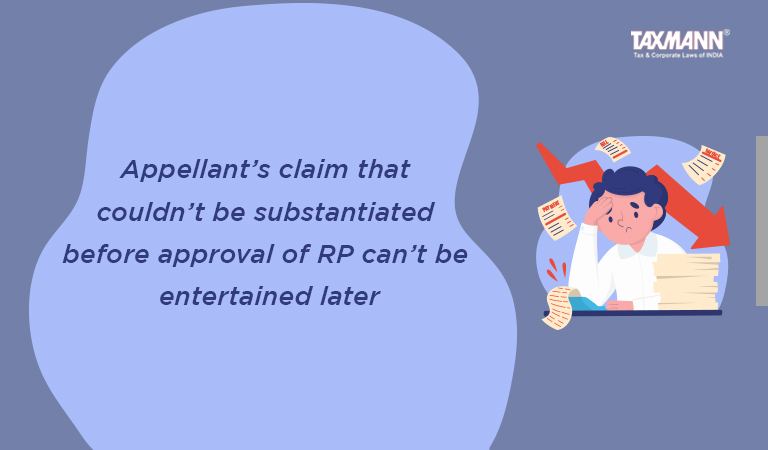Appellant’s claim that couldn’t be substantiated before approval of RP can’t be entertained later
- Blog|News|Insolvency and Bankruptcy Code|
- 2 Min Read
- By Taxmann
- |
- Last Updated on 24 December, 2022
Case Details: S.C. Brothers Lorry Transport Service v. Resolution Professional of Empee Distilleries Ltd. - [2022] 145 taxmann.com 387 (NCLAT-Chennai)
Judiciary and Counsel Details
-
- M. Venugopal, Judicial Member & Naresh Salecha, Technical Member
- I. Dinesh, Advocate for the Appellant.
- Ms Savitha, Advocate & Avinash Krishnan Ravi for the Respondent.
Facts of the Case
In the instant case, the CIRP was initiated against the corporate debtor and R1 was appointed as Resolution Professional (RP). The Resolution Plan submitted by the R2-Successful resolution applicant (SRA) was approved by the Adjudicating Authority (NCLT) by its impugned order.
Thereafter, the appellant-operational creditor filed an application before the NCLT seeking direction to respondents to make a payment towards the appellant’s claim from contingency funds. The RP submitted that he had requested the appellant to submit supporting documents to establish claims and had also listed the documents required.
However, the appellant had failed to furnish documents and, therefore, RP was not able to admit the claim of the appellant. The National Company Law Tribunal (NCLT) dismissed the application filed by the appellant. Thereafter, an appeal was made to the National Company Law Appellate Tribunal (NCLAT) against the order passed by the NCLT.
The appellant submitted that when a contingency fund was available, the NCLT ought to have directed the RP to accept the claims of the appellant and therefore, the NCLT had erred in rejecting the appellant’s claim.
NCLAT Held
The NCLAT held that the Adjudicating Authority (NCLT) rightly rejected a claim of the appellant on the ground that claims couldn’t be substantiated by furnishing the necessary supporting documents.
The NCLAT, further held that a claim couldn’t be entertained after the resolution plan was fully implemented and new management of SRA had taken over. Therefore, on qualitative and quantitative rumination of facts, the appeal was to be dismissed.
List of Cases Reviewed
-
- S.C. Brothers Lorry Transport Service v. Resolution Professional of Empee Distilleries Ltd. [2022] 145 taxmann.com 386 (NCLT – Chennai) (para 26) affirmed [See Annex].
- Ghanashyam Mishra & Sons (P.) Ltd. v. Edelweiss Asset Reconstruction Co. Ltd. [2021] 126 taxmann.com 132/166 SCL 237 (SC) (para 25) followed.
List of Cases Referred to
-
- Ghanashyam Mishra & Sons (P.) Ltd. v. Edelweiss Asset Reconstruction Co. Ltd. [2021] 126 taxmann.com 132/166 SCL 237 (SC) (para 5)
- Mukul Kumar v. RPS Infrastructure Ltd. [Company Appeal (AT) (Insolvency) No. 1050 of 2020] (para 23)
- Santanu T. Ray v. Tata Capital Financial Services [CA (AT) No. 951 of 2021] (para 25).
Disclaimer: The content/information published on the website is only for general information of the user and shall not be construed as legal advice. While the Taxmann has exercised reasonable efforts to ensure the veracity of information/content published, Taxmann shall be under no liability in any manner whatsoever for incorrect information, if any.

Taxmann Publications has a dedicated in-house Research & Editorial Team. This team consists of a team of Chartered Accountants, Company Secretaries, and Lawyers. This team works under the guidance and supervision of editor-in-chief Mr Rakesh Bhargava.
The Research and Editorial Team is responsible for developing reliable and accurate content for the readers. The team follows the six-sigma approach to achieve the benchmark of zero error in its publications and research platforms. The team ensures that the following publication guidelines are thoroughly followed while developing the content:
- The statutory material is obtained only from the authorized and reliable sources
- All the latest developments in the judicial and legislative fields are covered
- Prepare the analytical write-ups on current, controversial, and important issues to help the readers to understand the concept and its implications
- Every content published by Taxmann is complete, accurate and lucid
- All evidence-based statements are supported with proper reference to Section, Circular No., Notification No. or citations
- The golden rules of grammar, style and consistency are thoroughly followed
- Font and size that’s easy to read and remain consistent across all imprint and digital publications are applied








 CA | CS | CMA
CA | CS | CMA


